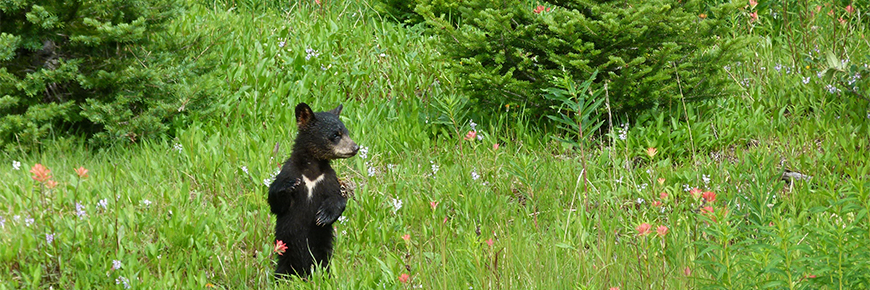
Black bears
Bears in the mountain national parks
Historical Range | Current Status | Threats | Biology | Habitat | Social Behaviour
Historical Range
In North America, the black bear (Ursus americanus) once ranged throughout forested areas across most of North America, from the east coast to the west coast and from Alaska to Mexico.
Current Status
Today, black bears still exist in about 60% of their historical range. They can be found in most non-urban areas of British Columbia and throughout Alberta with the exception of the southeast corner of the province. Black bears evolved in forest ecosystems; as a result, their current distribution is largely influenced by the amount of undisturbed forest cover available to them. A very general population estimate suggests there may be up to 600,000 black bears in North America and more than 380,000 in Canada. Due to their relatively robust numbers, black bears are not a Species at Risk in Canada.
Within the four contiguous Rocky Mountain national parks, population estimates are:
- Banff National Park: 20-40
- Jasper National Park: 90
- Yoho National Park: 20-50
- Kootenay National Park: 30-50
Threats
Black bears are wary of animal predators including grizzly bears, other black bears, and wolves. Their biggest threat? Human activity. Habitat fragmentation, habituation, and road and railway strikes take their toll on the black bear population in the mountain parks.
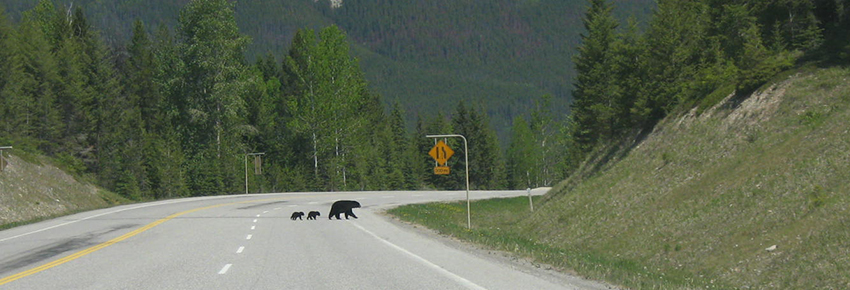
© Joanne Williams
Biology
In comparison with many animals found in the mountain parks, black bears have low reproductive rates. The age of first reproduction ranges from 3-4 years. A female can produce young every 2-3 years. Black bears can give birth to 1-5 cubs in a litter, but 2 is the norm.
Mating takes place in June and July. If the female is able to find good quality forage over the summer, the embryo will implant in the uterus in the fall due to a process called delayed implantation. Bears in the mountain parks are food-stressed at the best of times; ensuring they have secure habitat where they can access as much natural food as possible is vital to their success. If the female has built up enough fat reserves to get her through the winter, cubs will be born in the den in late January or February. The cubs weigh about 300 g (just over ½ lb) at birth and gain up to 2 kg (5 lb) before they emerge from the den in mid-April or early May.
Black bear offspring typically remain with their mothers for a year or longer, depending on the tolerance level of the mother. Bears that survive to become mature adults can live 20-30 years; however, most die at a much earlier age.
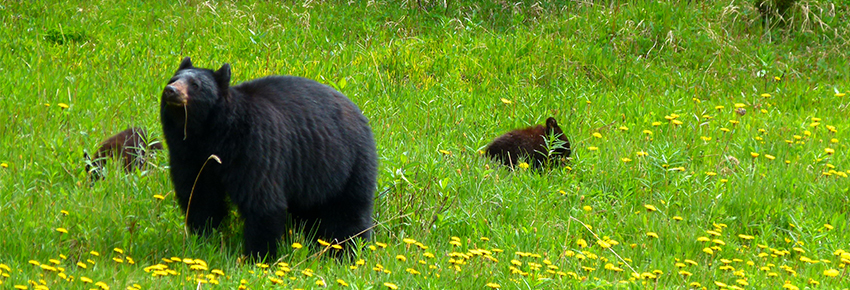
Female black bear with offspring
Black bears are adapted to forest environments where they can retreat to safe cover and climb trees if threatened. In the mountain parks, black bears have had to adapt to the presence of people. You are likely to see them in the montane valley bottoms along roadsides or near campgrounds, where openings in the forest cover promote vegetation growth.

Black bear in a tree
Food:
For bears in the mountain parks, it’s all about food. Black bears are omnivores, eating a combination of plants and meat. Plants are their main dietary source, providing up to 85% of their intake. In late summer and fall, berries provide crucial nutrition as bears feed around the clock in preparation for winter denning. Black bears eat many of the same foods that grizzly bears do, but because they have short claws, they do not rely as heavily on calories that require serious digging—like roots and ground squirrels.
Spring/Early Summer
- Dandelions
- Poplar buds/catkins
- Grasses and sedges
- Clover
- Horsetail (equisetum)
- Overwintered berries
- Deer, elk, moose calves
- Small animals
- Fish
- Carcasses of winter-killed ungulates
Late Summer/Fall
- Buffaloberry
- Crowberry
- Bearberry
- Grouseberry
- Currant berries
- Blueberry/huckleberry (west of Great Divide)
- Whitebark pine nuts
- Sarsaparilla
- Mushrooms
- Insects
- Small animals
- Fish
- Carrion
- Carcasses of elk weakened or injured during the fall rut
Black bears are also scavengers, taking advantage of whatever food they find: carcasses, grain spilled on railway tracks, fruit and seeds from backyard trees and bird feeders, your barbeque or picnic lunch, or garbage. This is why it is so important for us to exercise good management of bear attractants and store food and garbage properly in the parks. Bears that become hooked on human food sources may become a risk to public safety and may have to be destroyed.
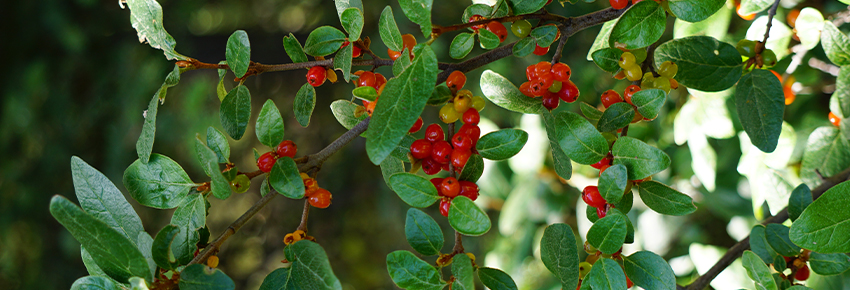
Buffaloberry
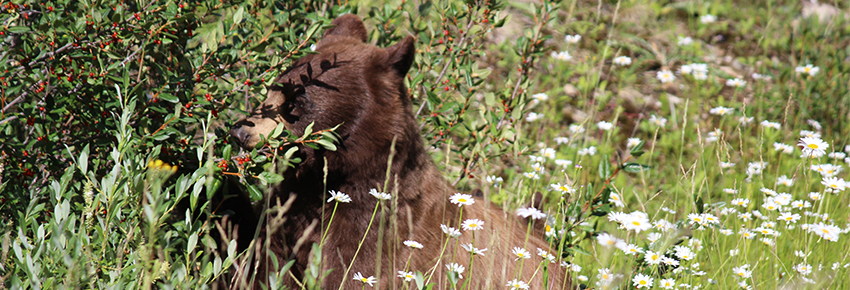
Cinnamon black bear eating buffaloberries
Shelter:
Black bears survive food-scarce mountain winters by denning for up to six months of the year. They prefer forest habitats and search for treed locations in valley bottoms. A suitable site may be under a tree stump, log or rock, or in a hole dug in a hillside. Female black bears will line their dens with grass, twigs and leaves.
Space:
A black bear's home range can cover up to 200 km2 and often overlaps with the territories of other bears. Female cubs establish their territories in the vicinity of their mother, but male cubs usually travel or disperse farther away. Black bears prefer to stick to areas with forest cover rather than open habitat when travelling.
As more grizzly bears disperse to higher elevations in the spring and early summer as green-up progresses, black bears tend to move to lower elevations to avoid grizzlies and feed on berries. For black bears, motor vehicle collisions are the leading cause of human-caused mortality in the mountain parks. In Banff National Park, black bears have become adept at using both wildlife overpasses and underpasses to cross the busy Trans-Canada Highway. However, their ability to climb trees also enables black bears to scramble over fence posts along the highway, exposing them to dangerous highway traffic.
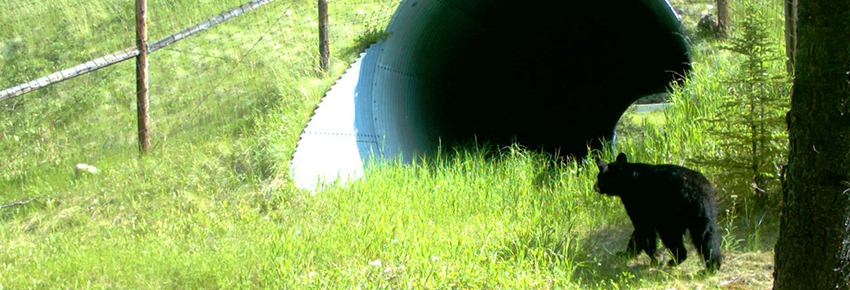
Remote camera image of a black bear using a highway wildlife underpass in Banff National Park
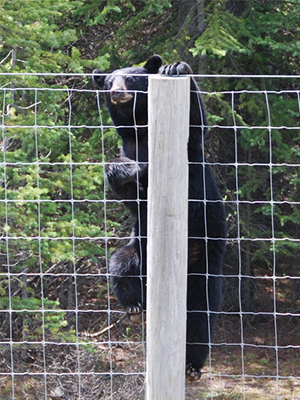
Black bear climbing over wildlife fencing along the Trans-Canada Highway in Banff National Park
J. Shepherd
Social Behaviour
Black bears are generally solitary outside of the mating season, with the exception of mothers with offspring. Black bears are more timid than grizzly bears and will most often defend themselves from threats such as other bears, wolves and humans by climbing trees.
These bears have quite the vocabulary, and use a variety of grunts, hums and vocalizations to communicate with each other. Some researchers, having overheard these conversations, say they can be surprisingly "human-like". Both black and grizzly bears also use scent-marking and rub trees to express their sentiments to other bears.
Related links
- Date modified :